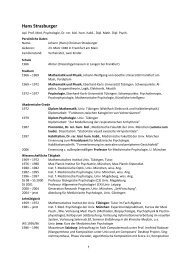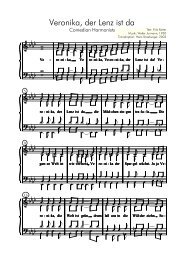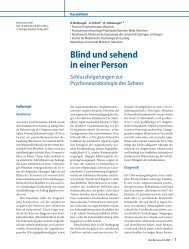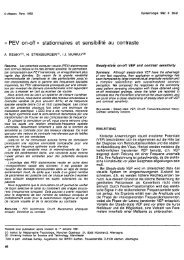Peripheral vision and pattern recognition: a review - strasburger - main
Peripheral vision and pattern recognition: a review - strasburger - main
Peripheral vision and pattern recognition: a review - strasburger - main
Create successful ePaper yourself
Turn your PDF publications into a flip-book with our unique Google optimized e-Paper software.
<strong>Peripheral</strong>_Vision.doc<br />
eccentricity; these are shown separately for on-center <strong>and</strong> off-center fields by the triangles <strong>and</strong><br />
plus signs in Figs. 11c (Fischer & May 1970, Fig. 2) (comparable results with a flatter increase<br />
were obtained by Peichl & Wässle, 1979, Fig. 7, for cat Y cells: 0.8° @fovea; 2.3° @24°). In<br />
modern writing (cf. Equation 7), a generalized version of Riccò’s law is thus<br />
(<br />
0<br />
E2<br />
Δ L / L)<br />
⋅ A = c (1+<br />
E / ) , (17)<br />
with the same notation as before.<br />
Receptive field sizes in the monkey <strong>and</strong> human are different from those in the cat. De<br />
Monasterio <strong>and</strong> Gouras (1975, Fig. 16) describe the sizes of macaque retinal ganglion cells, of<br />
which the broad-b<strong>and</strong> cells are of interest here. Although their sizes vary widely, their variation<br />
with eccentricity is quite regular on average (filled circles in Figure 12c). These cells could<br />
represent a physiological substrate for mediating Riccò’s law as shown quantitatively by Oehler<br />
(1985).<br />
For that analysis, Oehler used the Westheimer paradigm as a psychophysical estimate of<br />
receptive-field size. Since light energy of a homogeneous patch of light is proportional to its<br />
area, the limit up to which threshold is proportional to area (i.e., up to which Riccò’s law applies)<br />
provides an estimate of receptive field size. However, as seen in Figure 12b, the borders of the<br />
spatial summation area are not well defined. To achieve a more precise estimate, Westheimer’s<br />
paradigm interchanges the roles of the variables: The size of the stimulus, whose increment<br />
threshold is sought, is kept constant, <strong>and</strong> the size of a background annulus is varied instead.<br />
With increasing size of the latter, the threshold increases to a maximum <strong>and</strong> then decreases to<br />
a plateau further out. This so-called Westheimer function (Westheimer, 1965, first described by<br />
Crawford, 1940) is interpreted as showing that, as long as the annulus fits into the mean size of<br />
a receptive field, the threshold increases from an increased adaptation level. With a larger<br />
background, then, surrounding inhibitory areas slightly decrease the adaptation level.<br />
Consequently, the diameter at which the function’s maximum is reached is taken as an estimate<br />
of the (mean of the) inner, summating part of the receptive field. The beginning of the plateau<br />
region is regarded as an, psychophysically obtained, estimate of the mean total receptive field<br />
size including the inhibitory surround. Such estimates were called perceptive fields by Jung <strong>and</strong><br />
Spillmann (1970) (cf. also Spillmann, 1964).<br />
Psychophysical data from the Westheimer paradigm had previously only been available for the<br />
human, whereas receptive-field data existed only for cat <strong>and</strong> monkey. Oehler (1985) provided<br />
the missing link, namely psychophysical data for the monkey which could then be compared<br />
with neurophysiology. The open <strong>and</strong> filled circles in Figure 12c show the decisive result. The<br />
open circles refer to Oehler’s perceptive-field sizes in the monkey <strong>and</strong> the filled circles depict de<br />
Monasterio <strong>and</strong> Gouras’ receptive field sizes for the broad b<strong>and</strong> cells. It is striking how well the<br />
36






